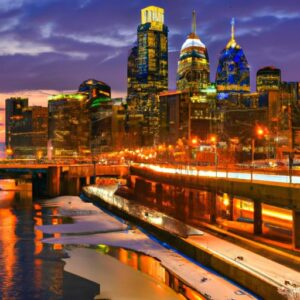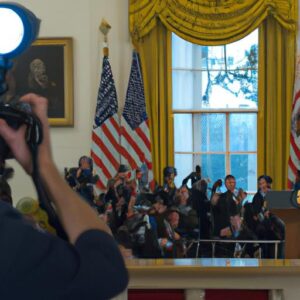In a world where technological advancements are rapidly reshaping various industries, it’s only natural to wonder about the future of photography. With the rise of Artificial Intelligence (AI), many have raised the question: will photography be replaced by ai? Let’s delve into this intriguing topic and explore the possibilities.
A Brave New World of Advancements in AI
Artificial Intelligence has made significant strides in recent years, revolutionizing various sectors. From self-driving cars to voice assistants, AI has become an integral part of our daily lives. This technology has also found its way into the field of photography, offering exciting possibilities for both amateurs and professionals.
Photography: A Blend of Skill and Creativity
Photography, as an art form, has long relied on the keen eye and creative vision of human photographers. It’s the ability to capture emotions, tell stories, and evoke feelings through a single frame that sets photography apart. But can AI truly replicate such human ingenuity?
Questioning the Possibility
While AI has made remarkable progress in image recognition and editing, it still falls short when it comes to the intangible aspects of photography. Emotions, artistic vision, and the ability to perceive the subtle nuances of a scene are elements that define the art of photography and remain uniquely human.
So, does this mean AI will never replace photography? Stay tuned as we delve deeper into the impact of AI on the field of photography, exploring its role, limitations, and the potential future it holds. Together, we’ll uncover whether AI has the power to replace the artistry and creativity that human photographers bring to the table.
Section 1 words
The Impact of AI on Photography
Advancements in AI Technology for Image Recognition and Editing
AI has made significant strides in image recognition and editing, revolutionizing the way we capture and manipulate photographs. With advanced algorithms and machine learning capabilities, AI can now identify objects, scenes, and even faces with remarkable accuracy. This has streamlined the editing process, enabling photographers to save time and enhance their images effortlessly.
Integration of AI in Camera Systems and Smartphones
AI has also found its way into camera systems and smartphones, empowering users with intelligent features that improve the quality of their photographs. From automatic scene detection to optimized settings, AI algorithms work behind the scenes to ensure that every shot is well-exposed, balanced, and visually appealing. This integration has made photography more accessible to a wider audience, allowing beginners to capture stunning images effortlessly.
Enhancing Accessibility and Convenience of Photography
One of the most significant impacts of AI on photography is its ability to enhance accessibility and convenience. With AI-powered smartphones and cameras, anyone can now capture professional-looking photos without extensive knowledge or technical expertise. AI algorithms analyze the scene, adjust settings, and apply filters automatically, resulting in visually appealing images with minimal effort. This democratization of photography has opened doors for aspiring photographers and enthusiasts to express their creativity effortlessly.
As we explore the impact of AI on photography, it becomes clear that AI has brought tremendous advancements to the field. From image recognition and editing to integrated camera systems, AI has enhanced the accessibility and convenience of photography, making it more enjoyable for everyone.
Section 2 words
AI vs. Human Creativity in Photography
Analyzing the Creative Aspects of Photography
Photography is a form of artistic expression that goes beyond capturing mere images. It involves composing frames, understanding light and shadows, and conveying emotions through visual storytelling. Human photographers possess a unique ability to infuse their creative vision into each shot, resulting in captivating and evocative photographs. This artistic touch is what sets photography apart from a purely technical endeavor.
Examining the Limitations of AI in Capturing Emotions and Artistic Vision
While AI has made incredible advancements in image recognition and editing, it still struggles to capture the depth of human emotions and translate them into photographs. Emotions are complex and nuanced, requiring an understanding of cultural context and personal experiences. Although AI algorithms can analyze facial expressions, they lack the ability to truly comprehend the emotions being expressed. This limitation hinders AI’s capacity to create photographs that evoke genuine emotional responses.
Furthermore, artistic vision is often subjective and deeply personal. It encompasses the photographer’s unique perspective, style, and storytelling abilities. AI, with its data-driven approach, finds it challenging to replicate the intricacies of human creativity. It may excel at mimicking certain styles or techniques, but it falls short in delivering the soul and authenticity that human photographers bring to their work.
The Importance of Human Input in Photography Composition and Storytelling
Photography is not just about capturing a scene; it’s about composing it in a way that tells a story and engages the viewer. Human photographers have an intuitive sense of composition and can skillfully arrange elements within the frame to create visually appealing and meaningful photographs. They make deliberate choices regarding perspective, framing, and focal points to convey their intended message. AI, on the other hand, lacks the human touch required to make these artistic decisions.
Moreover, human photographers possess the ability to connect with their subjects on a deeper level, establishing trust and rapport. This connection allows them to capture genuine emotions and candid moments that reflect the essence of the subject. AI, with its computational approach, struggles to establish such connections and often produces photographs that lack the depth and authenticity brought forth by human interaction.
Section 3 words
AI’s Role in Automated Photography
With the advancement of AI technology, we are witnessing the rise of AI-powered automated photo-taking devices. These devices are equipped with sophisticated algorithms that can analyze scenes and make decisions on exposure, composition, and even timing, all without human intervention. Let’s explore the implications of this trend and its potential impact on the world of photography.
A. Exploring the Rise of AI-Powered Automated Photo-Taking Devices
Automated photography is no longer limited to traditional cameras; it has expanded to include smartphones, drones, and even specialized devices designed solely for capturing stunning images. These AI-powered devices utilize machine learning algorithms to understand and adapt to various shooting scenarios, resulting in high-quality photographs accessible to all.
B. Discussing the Pros and Cons of Automated Photography
The emergence of automated photography has its fair share of advantages and disadvantages. On the positive side, these devices allow beginners to capture professional-looking images effortlessly. The AI algorithms take care of technical aspects such as exposure and focus, freeing users to focus on composition and creativity. However, some argue that this convenience comes at the expense of learning essential photography skills and understanding the nuances of manual shooting.
C. The Potential Impact of Automated Photography on Professional Photographers
As AI-powered automated photography gains popularity, professional photographers may face challenges and changes in their field. While automated devices can produce impressive results, they lack the artistic vision and storytelling abilities that human photographers possess. Professionals must adapt and leverage AI technology to enhance their creative processes rather than fear being replaced. The collaboration between AI and human photographers can lead to innovative approaches and new artistic possibilities.
As we navigate the evolving landscape of automated photography, it’s crucial to strike a balance between the convenience offered by AI and the irreplaceable human touch that makes photography a captivating art form.
Section 4 words
The Future of Photography with AI
Predictions on the Future Integration of AI in Photography
As technology continues to evolve at a rapid pace, the integration of AI in photography is poised to play a significant role in shaping its future. Experts predict that AI will continue to advance and become more sophisticated, offering photographers a range of innovative tools and capabilities.
AI-powered cameras and smartphones are already changing the way we capture and edit photos. In the future, we can expect AI algorithms to become even more intelligent, enabling cameras to automatically adjust settings based on the scene, lighting conditions, and desired outcome. This will empower photographers of all skill levels to capture stunning images effortlessly.
AI Complementing and Enhancing Human Photographers’ Skills
Rather than replacing human photographers, AI has the potential to become a powerful tool that complements and enhances their skills. AI algorithms can assist photographers in various ways, such as suggesting composition techniques, optimizing post-processing workflows, and analyzing data to identify trends and preferences.
By leveraging AI, photographers can focus more on their creative vision and storytelling, knowing that the technical aspects are being handled efficiently. This partnership between human photographers and AI technology opens up new possibilities for artistic expression and pushes the boundaries of what can be achieved in the realm of photography.
The Potential for AI to Revolutionize Photography Techniques and Styles
AI’s ability to analyze vast amounts of data and learn from patterns presents an exciting opportunity to revolutionize photography techniques and styles. With AI, photographers can explore new aesthetics, experiment with unique editing styles, and push the limits of traditional photography norms.
Imagine an AI-powered camera that can instantly apply the visual style of a renowned photographer to your shots, or an AI assistant that suggests creative angles and perspectives based on popular trends. These advancements have the potential to inspire photographers to think outside the box and create images that were previously unimaginable.
Section 5 words
Conclusion
After exploring the impact of AI on photography and contemplating the possibility of AI replacing this cherished art form, we can conclude that while AI has undoubtedly transformed the field of photography, it is unlikely to fully replace the human touch.
Throughout this article, we have witnessed the remarkable advancements AI has brought to photography, from image recognition and editing to the integration of AI in camera systems. AI has undeniably enhanced the accessibility and convenience of photography, making it more approachable for enthusiasts and professionals alike.
However, the creative aspects of photography, which involve capturing emotions, telling stories, and conveying unique perspectives, remain firmly rooted in the realm of human vision. AI may excel at technical aspects, but it struggles to replicate the artistic intuition and subjective interpretation that human photographers bring to their work.
As we envision the future of photography, it is more likely that AI will serve as a powerful tool, complementing and enhancing the skills of photographers rather than replacing them. The collaboration between human creativity and AI technology holds immense potential for pushing the boundaries of photography, opening up new possibilities and inspiring innovation.
So, while AI continues to evolve and shape the world of photography, it is the human touch that will forever be the driving force behind capturing those unforgettable moments and immortalizing them through the lens.
In conclusion, photography will not be replaced by AI, but rather transformed and elevated by its symbiotic relationship with human photographers, enabling us to explore new frontiers and redefine the art form.
Section VI words





